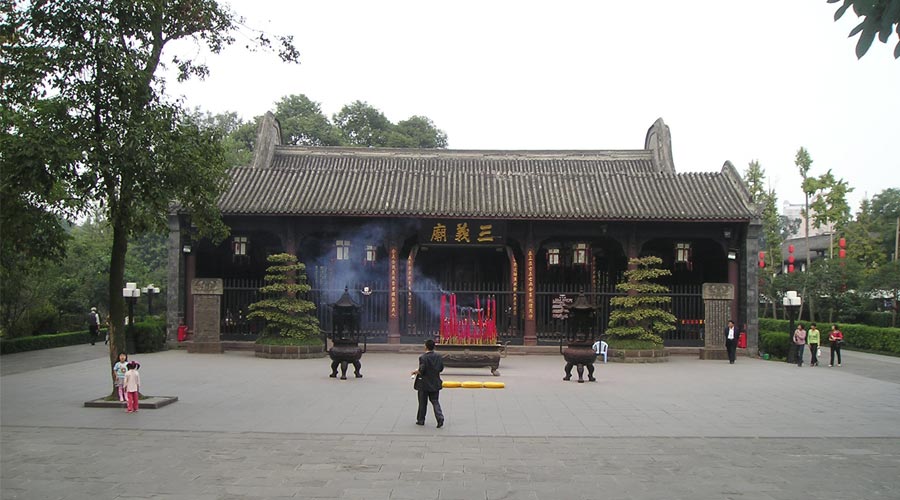History of Wuhou Temple
The establishment date of the Wuhou Memorial Temple is not definite, but it is said that this temple was built after the Liu Bei Temple. The Wuhou Temple that we can see today was rebuilt in 1672. The plaque text in the entrance of the temple is “Zhaolie Temple of Shuhan Kingdom”. Zhaolie is a reference to Liu Bei’s posthumous title.
Inside Wuhou Memorial Temple
The Temple’s main sections are some constructions including the front gate, the second gate, the Temple of Liu Bei, the Temple of Zhuge Liang, and Sanyi Temple, which run on the south to the north axis. Near this place, you can find the tomb of Liu Bei.
Triple-Success Stele, A Valuable Relic in Wuhou Shrine
This stele is about the morality and achievements of Zhuge Liang. It is written by Pei Du, a Tang Dynasty famous minister who served four emperors in succession. The calligraphy of this piece is done by Liu Gongquan, who was one of the most brilliant calligraphers throughout Chinese history.
Temple of Liu Bei
After you pass through the second gate, you will encounter the splendid Temple of Liu Bei. It is also known as Zhaolie Temple, which refers to the title that Liu Bei earned when he became emperor. Liu Bei is a very beloved character in Chinese history. He was a short-time ruler during the Three Kingdom, but because of his honor and wits, he is still one of the most beloved Chinese historical figures.
There is a golden Liu Bei sculpture located in the inner middle part of the temple, which is 3 meters (9.84 feet). Also, you can find a sculpture of Liu Chen, Lie Bei’s grandson. On the west side of the courtyard, you can see the statues of Zhang Fei and his descendants. On the east side, there are sculptures of Guan Yu and his descendants. Both Guan Yu and Zhang Fei were Liu Bei’s sworn brothers and highest-ranking generals. In front of each statute, there is a small stele, which is about each figure’s name and accomplishments.
Temple of Zhuge Liang
After the Zhaolie Temple and just a few steps on the way, you can find the Temple of Zhuge Liang. Zhuge Liang was nicknamed “Wolong” or “Fulong”, which means “Sleeping Dragon” or “Crouching Dragon”. He earned this nickname for his excellent reputation as an intelligent scholar. He was a wise and respected man, mostly portrayed with a crane feathers hand fan wearing a Taoist robe.
In the center of the temple, there are statues of Zhuge Liang and three generations of his descendants. In front of the figure, there are three bronze drums with exquisite patterns. It is said that the drums were made when Zhuge Liang marched the south as the leader of the army; so, they are named Zhuge Drums.
Looking at the Temple of the Zhuge Liang roof, you will see Chinese calligraphy, which is written by Zhuge Liang. It is named “Advice to My Son” and translated as “One cannot demonstrate paragons without living simply. One cannot have grand ambitions without a peaceful state of mind.”
Sanyi Temple
Sanyi Temple is made up of three sections: the Temple, Corridors, and Prayer. Inside the temple, you can see vibrant statues of Liu Bei, Guan Yu, and Zhang Fei. Liu Bei’s sculpture is 2.8 meters (9.19 feet); however, the figures of Guan Yu and Zhang Fei are both 2.6 meters (8.53 feet). This difference demonstrates the importance of the Emperor and his officials. Here, there are two black stele groups with 2.3 meters (7.54 feet) in height.
Tomb of Liu Bei
In the western section of Wuhou Temple, you can visit the Hui Ling Mausoleum or The Tomb of Liu Bei. This place dates back to over 1700 years ago and it is preserved pretty well. Due to the respect and love that the Chinese have for Liu Bei, this place has not been vandalized during the years. It is also regularly visited by many Chinese people to pay their respects. In 1825, a round brick wall was built surrounding the temple.
Tourist Guide
[wpsm_colortable color=”main-color”]
| How to get to? | |
|---|---|
| By Metro | Take Line 3 and leave at Gaoshengqiao. Then walk toward the east along Wuhouci Avenue for about 5 minutes, and you will see the temple. |
| By Bus | Take 1, 57, 82, 334, 335, or 1126 to Wuhou Shrine (Wuhou Ci) Station. |
| Prices | |
| Adults | 50 Yuan |
| Children (6-8 years old) | 25 Yuan |
| Children (under 6 years old) | Free |
| Opening Hours | |
| November – April | 8:00 – 18:30 |
| May – October | 8:00 – 20:00 |
[/wpsm_colortable]
If you want to make the most of it, you should set aside 4 hours to visit the temple. Do you have any more information to add? Feel free to leave your comments, thoughts, and questions for us. Our professional experts will reply to your questions as soon as possible.
